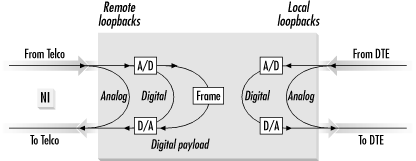Chapter 11. T1 Troubleshooting
Anything that can go wrong, will.
As with much else in networking, T1 troubleshooting is often an exercise in patience. T1 is only a physical layer specification with a basic framing protocol used to ensure synchronized timing between the ends. Working with T1s requires patience because of the frequent need to consult with others, whether telco technicians, ISP engineers, or equipment-vendor support personnel. Because T1’s popularity exploded quickly, many people are not well equipped to deal with the layers of complexity and multiple organizations needed to bring problems to resolution.
Basic Troubleshooting Tools and Techniques
Before involving others, it helps to pinpoint the problem as accurately as possible. To do this, trace the signal from the origin to its intended destination and make a note of where it fails to propagate. Your main tools are the CSU/DSU’s loopback features, though you may wish to involve equipment vendors and service providers.
Loopback Testing
Loopback testing is used to verify that a span is good by “looping” received data back onto the transmit path. Two main types of loopback exist; both are illustrated in Figure 11-1.

Figure 11-1. Remote loopback and local loopback
Remote loopback sends the data received on the telco network interface back out toward the telco to verify the line between two locations. ...
Get T1: A Survival Guide now with the O’Reilly learning platform.
O’Reilly members experience books, live events, courses curated by job role, and more from O’Reilly and nearly 200 top publishers.

